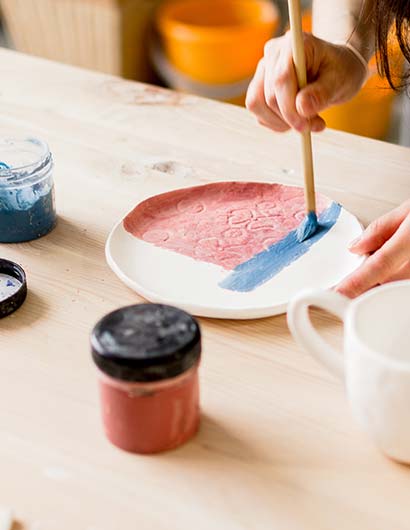
16 Jul Art Therapy Career: Turning Your Passion into Healing Power
Pursuing an Art Therapy Career
Hey there! Ever looked at your art and thought it could be more than just a hobby or a way to ace your art class? What if your art could actually help people heal, grow, and understand themselves better? That’s exactly what an art therapy career offers. It’s this cool blend of creativity and care that can make a real difference in the world. So, if you’re curious about how to transform your passion for art into a career that touches lives, you’re in the right spot. Today, we’re going to discuss art therapy – discovering what it is, the best majors for it, the skills you’ll need, and yes, even how to make a living doing it. Ready to explore how your art can heal? Let’s get started!
What is Art Therapy?
Think of art therapy as your art’s chance to be a hero. It’s not just about making cool stuff; it’s about using your favorite mediums – be it paint, clay, or something else – to help people sort through their thoughts and feelings. Picture yourself as the guide on an epic quest of self-discovery and healing, with your art supplies as the magic tools. Basically, art therapy combines your creative spark with psychology smarts to help tackle the tricky bits of life. Pretty awesome, right?
What do Art Therapists Do?
So, what’s a day in the life of an art therapist like? Well, essentially, it’s one part artist, one part detective, and one part best friend. Art therapists work with all kinds of people to help them express feelings they might not even know how to say out loud. Using art, they help uncover deep thoughts and emotions, guiding people toward healing and understanding themselves better. Whether it’s in schools, hospitals, or private studios, art therapists create a space where art isn’t just art – it’s a bridge to wellness. In other words, it’s about using art to make a difference.
Let’s take a closer look:
Building Connections: First off, art therapists chill with those they help, making sessions feel more like a relaxed meetup than a stiff appointment.
Doing Their Homework: They dig into people’s past stories, not for the gossip, but to truly understand where they’re coming from.
Teamwork Makes the Dream Work: They collaborate with doctors, nurses, and other pros to whip up the best healing strategies.
Keeping Tabs: Tracking progress is like following a binge-worthy show – they keep an eye on all the ups and downs.
Planning the Artventure: They plot out the therapy roadmap, using art as their vehicle for exploration and healing.
Artistic Guide: They’re the Yoda to their patients’ Luke Skywalker, guiding them through art projects that do more than just look pretty.
Art Whisperers: They interpret the hidden messages in art to understand what’s really being said without words.
Tweaking the Process: If something’s not working, they’re ready to mix it up, always searching for the right approach.
Decoding the Art: They help patients find the messages in their own artwork, turning “I just felt like painting” into meaningful insights.
What Major is Best for Art Therapy?
Choosing the right major for an art therapy career is a lot like mixing the perfect paint palette. You’re looking for that sweet spot where understanding people and mastering art meet. Here’s the lineup of majors that you should consider:
Psychology: Learn about the human mind because understanding why people do what they do is crucial.
Fine Arts or Studio Arts: Sharpen your art skills, as you’ll be using them to help others express themselves.
Art Therapy: Some schools offer this as a major, which is like hitting the jackpot because it’s tailored to this exact career.
Counseling: This major helps you become the go-to person for support, lighting the way for others when the going gets tough.
As you can see, majors that mix understanding people with creating art are your golden ticket. Think of it as preparing for a role where you’re part artist, part therapist, and all about making a difference. Whether you choose psychology with a side of art classes or go full tilt into an art therapy program, you’re on the right track.
What Skills Do You Need to Be an Art Therapist?
Yet, becoming an art therapist isn’t just about being good at art or wanting to help people. It’s a mix of specific skills that let you work magic in the therapy room. Here’s what you’ll need:
Artistic Talent: Obviously, right? You gotta have those creative chops to guide others in expressing themselves through art.
People Skills: Being able to connect and build trust with folks from all walks of life is crucial.
Empathy: Understanding and feeling what others are going through is key to helping them heal.
Communication: You need to be able to share ideas clearly, both in speaking and through art.
Psychology Know-How: A solid understanding of mental health and emotional issues helps you tailor your approach to each individual.
Patience and Flexibility: Every person you help will be on their own unique journey. Being patient and adaptable is a must.
Problem-Solving: Being able to think on your feet and come up with creative solutions is part of the job.
Observational Skills: To provide effective support, you’ll need to notice the small details in someone’s artwork and behavior.
Pros of Choosing an Art Therapy Career
Are you starting to picture yourself in an art therapy career? Awesome! You’re looking at a path that’s not just fulfilling for you but also makes a big difference in other people’s lives. Let’s explore why choosing art therapy could totally change the game for you:
Make a Real Difference: There’s something incredibly rewarding about using your skills to help others heal and grow.
Creative Daily Work: Your office? A canvas. Your meetings? Art sessions. Each day throws open the doors to a whole new world of creativity.
Diverse Work Environments: From schools and hospitals to private studios and community centers, art therapists work in various settings, keeping things fresh and exciting.
Continuous Learning: The field is always evolving, which means you’re always learning – about art, psychology, and the unique stories of those you help.
Building Deep Connections: This career allows you to form meaningful relationships with people by supporting them through their healing journey.
Flexibility: Many art therapists have the opportunity to set their own schedules or even start their own practice, offering a great work-life balance.
Growing Demand: As more people recognize the value of holistic healing practices, the demand for art therapists continues to rise.
What to Watch Out For in an Art Therapy Career
As you can see, heading into an art therapy career is super rewarding, but let’s keep it real: it’s not all smooth sailing. There are a few challenges you might bump into along the way. Just like in any epic video game, these obstacles are what make the journey interesting and totally worth it. Let’s dive into what those tough bits might be and how you can tackle them like a boss.
Getting Qualified: It takes some serious schooling and certifications to become an art therapist. This means time, dedication, and, yes, dealing with tests and projects.
Building Experience: Like leveling up in a game, you’ve got to build your experience. This can mean internships or volunteer work before landing that dream job.
Emotional Load: Art therapy can be heavy. You’re dealing with real people and real issues, so learning how to manage that emotional load is critical.
Public Awareness: Not everyone gets what art therapy is all about. You might find yourself playing the role of educator, explaining the value of what you do.
Finding Jobs: The job market can be competitive. It’s like trying to find a rare item; sometimes, you’ve got to search a bit harder.
Financial Considerations: Starting out, the pay might not be what you’re dreaming of. It’s about balancing passion with practicality until you hit your stride.
How Do Art Therapists Make Money?
So, how do art therapists turn their passion and skills into a paycheck? It’s all about finding the right channels to apply their expertise. Here’s the scoop:
Working in Various Settings: Many art therapists work in hospitals, schools, rehabilitation centers, and private practices. Each setting offers different opportunities to earn.
Private Practice: For those who dream big, starting your own practice can be a game-changer. It’s like being the boss of your art studio but with a therapeutic twist.
Workshops and Group Sessions: Hosting art therapy workshops or group sessions is another way to spread the healing power of art and boost income.
Consulting: Experienced art therapists often consult for organizations or educational institutions, adding an extra layer to their income sources.
Selling Art: Some art therapists choose to conduct art classes or sell their art on the side, merging their therapeutic knowledge with direct art sales.
How Much Do Art Therapists Make?
Alright, let’s talk numbers. How much can you expect to make as an art therapist? Well, like any career, it varies based on where you are, who you work for, and how much experience you’ve got under your belt. On the cash front, art therapists in the U.S. could be pulling in anywhere from $40,000 to a cool $100,000+ per year. Not too shabby, right? But keep in mind that those with more experience or who run their own practice might see higher numbers. Remember, as you grow in your career and expand your expertise, your potential earnings can climb, too. It’s all about investing your passion and skills into this rewarding career path.
How to Start Your Art Therapy Career
Kickstarting your career in art therapy is like preparing for a big art project – you need the right tools, a bit of planning, and a lot of passion. Here’s how to get the ball rolling:
Pursue the Right Education: Look into programs that offer a blend of psychology and art courses. Earning a degree in art therapy or a related field is your first big step.
Gain Experience: Consider internships, volunteering at community centers, or working in settings where art therapy is practiced. This hands-on experience is invaluable.
Get Certified: Research the certification requirements in your area. Becoming a registered or board-certified art therapist adds credibility to your practice.
Build Your Network: Connect with current art therapists, join professional associations, and attend workshops or conferences to immerse yourself in the community.
Create Your Portfolio: Showcase your artistic skills and any therapeutic projects or workshops you’ve led. This portfolio will be a vital asset in your job hunt.
Start Small: Consider working part-time in various settings to discover what fits best for you. Every bit of experience helps shape your unique path.
Final Thoughts
Now that you know what an art therapy career is, are you interested? It’s honestly one of those paths that’s as rewarding as it is cool. Whether you’re just learning about it or you’re all in, ready to make a splash, remember this: Your art and your desire to make a difference can shape an amazing career. So, keep pushing your creativity, never stop learning, and who knows? You might just find yourself with a job that’s as fulfilling as your most inspired artwork. Here’s to making your mark with colors, textures, and the kind of impact that lasts way beyond the canvas. Let’s make it happen!





Sorry, the comment form is closed at this time.